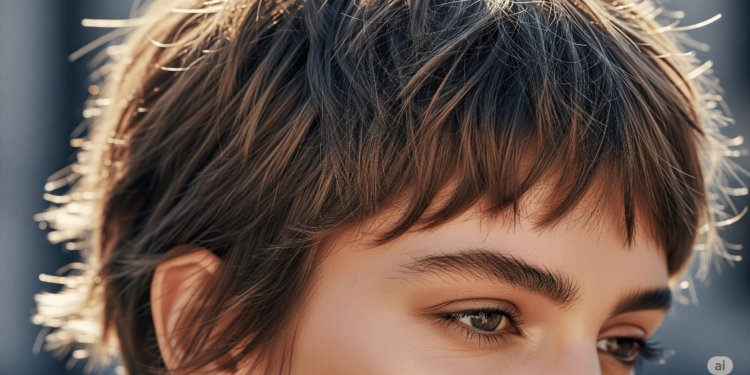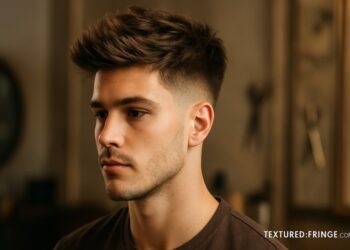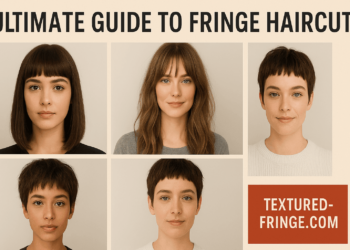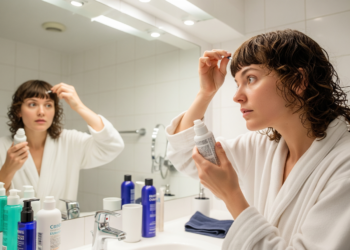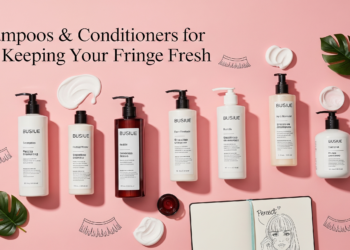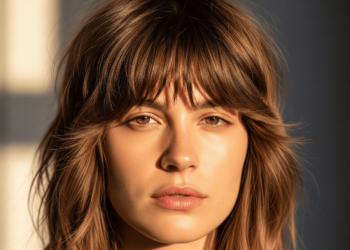There’s something absolutely magnetic about a textured fringe that just screams confidence. I remember the first time I saw someone rock a choppy, asymmetrical fringe with a pixie cut – it was like watching someone transform into their most badass self right before my eyes.
Short hair with textured fringe isn’t just a trend; it’s a statement. It’s for those who want to shake things up without committing to something completely outrageous. And honestly? It works on pretty much everyone, which is why I’m completely obsessed with this look right now.
Why Textured Fringe is Having Its Moment
Let’s be real – smooth, blunt cuts had their time, but textured fringe brings something different to the table. It’s got movement, personality, and that effortless vibe we’re all chasing. Unlike those perfectly straight-across bangs that require daily maintenance (and let’s face it, never look quite right after you sleep on them), textured fringe is forgiving.
The beauty lies in the imperfection. Those choppy, uneven pieces? They’re not mistakes – they’re features. This style embraces natural hair movement and actually looks better when it’s a little messy.
Best Short Cuts for Textured Fringe
The Choppy Bob with Wispy Fringe
This one’s a crowd-pleaser. You’ve got the classic bob length (think hitting right at your jawline), but with layers that create movement throughout. The fringe here isn’t heavy – it’s wispy and broken up, giving you coverage without looking like you’re hiding behind your hair.
I’ve seen this look work wonders on people with fine hair because the choppy layers create the illusion of thickness. Plus, it’s professional enough for work but edgy enough for weekend adventures.
Pixie Cut with Asymmetrical Fringe
Now we’re talking bold. This is for those who want to make a statement without saying a word. The pixie gives you that liberating feeling of minimal maintenance, while the asymmetrical fringe adds an unexpected twist.
What I love about this combo is how it frames the face. That longer side sweep draws attention to your eyes, while the shorter sections on the other side show off your bone structure. It’s flattering and fierce.
The Shag with Textured Bangs
The modern shag is having a serious comeback, and pairing it with textured fringe is pure genius. You get all that rock-and-roll attitude with layers that start at your ears and create this amazing movement throughout your hair.
The fringe here is usually longer and more piece-y, blending seamlessly into the face-framing layers. It’s the perfect “I woke up like this” vibe that actually takes some skill to achieve.
Styling Tips That Actually Work
Here’s where most people get frustrated – they love the look at the salon but can’t recreate it at home. Trust me, I’ve been there. The key is understanding that textured fringe isn’t meant to be perfect.
The Right Products Make All the Difference
Forget heavy creams and gels. You want lightweight products that enhance texture without weighing your hair down. A texturizing spray is your best friend here. Spritz it on damp hair, scrunch a bit, and let it air dry.
For days when you need more hold, a light mousse works wonders. But here’s the trick – apply it to the lengths first, then barely touch the fringe. Too much product on your bangs will make them look greasy and flat.
The Styling Technique
Don’t overthink this. Seriously. The more you fuss with textured fringe, the less natural it looks. After washing, gently towel dry (no aggressive rubbing), add your product, and either let it air dry or use a diffuser on low heat.
If you must use a blow dryer, flip your head upside down and dry from the roots. This creates natural volume and movement that you just can’t get when blow drying normally.
Face Shapes and What Works Best
I know everyone talks about face shapes, but it really does matter with fringe. The good news? Textured fringe is incredibly versatile.
Round Faces
Skip the straight-across fringe and go for something with more movement. A side-swept textured fringe that’s longer on one side creates angles and draws the eye upward. The choppy bob with wispy fringe I mentioned earlier? Perfect for round faces.
Square Faces
You want to soften those strong jawlines, and textured fringe does this beautifully. The uneven lengths break up the geometric lines of your face. A longer, piece-y fringe that sweeps to the side works particularly well.
Heart-Shaped Faces
Lucky you – almost any textured fringe works with your face shape. You can go bold with a choppy, asymmetrical cut or keep it subtle with wispy layers.
Color Considerations That Elevate the Look
Here’s something people don’t talk about enough – color can make or break a textured fringe. The choppiness and movement of this cut actually shows off color beautifully.
Highlights and Lowlights
The uneven lengths of textured fringe create natural opportunities for dimension. Strategic highlights can emphasize the texture, while lowlights add depth. It’s like the cut was made for dimensional color.
Bold Color Choices
Feeling adventurous? Textured fringe is the perfect canvas for fun colors. The choppy nature of the cut means you can do subtle peeks of color or go full rainbow – both look intentional rather than accidental.
Maintenance: The Real Talk
Let’s address the elephant in the room – maintenance. Any fringe requires upkeep, but textured fringe is actually more forgiving than you might think.
You’ll need trims every 4-6 weeks to keep the shape fresh, but here’s the beauty of textured cuts – they grow out well. Unlike blunt fringe that looks awful the moment it gets too long, textured fringe just gets… more textured.
Between salon visits, you can trim any pieces that are driving you crazy, but do it sparingly. The uneven nature of the cut means small imperfections actually work in your favor.
Common Mistakes to Avoid
I’ve seen people make the same mistakes over and over, so let’s clear these up:
Over-styling: The whole point is to look effortless. If you’re spending 30 minutes perfecting your fringe every morning, you’re doing it wrong.
Wrong products: Heavy, shiny products will kill the texture. You want matte finishes and lightweight formulas.
Fighting your natural texture: If you have curly hair, don’t try to make your textured fringe pin-straight. Work with what you’ve got.
Who Should Consider This Look
Honestly? Almost everyone. But it’s especially great if you’re looking to add some edge to your style without going too dramatic. It works whether you’re 22 or 52, in corporate America or the creative industry.
It’s also perfect for those who want a low-maintenance style that still looks put-together. The textured nature means it looks good even when you haven’t touched it since yesterday.
The Confidence Factor
There’s something about getting a textured fringe that just makes you feel different. Maybe it’s the way it frames your face, or how it moves when you walk. Whatever it is, there’s definitely a confidence boost that comes with this cut.
I think it’s because textured fringe feels intentional without being uptight. It says you care about how you look but you’re not precious about it. And in a world where we’re all trying to find that balance between put-together and approachable, textured fringe hits that sweet spot perfectly.
Frequently Asked Questions
How often do I need to trim textured fringe?
You’ll want to get it trimmed every 4-6 weeks to maintain the shape and prevent it from looking too grown out. However, textured fringe is more forgiving than blunt cuts, so you can sometimes stretch it to 8 weeks if needed.
Can textured fringe work with curly hair?
Absolutely! In fact, curly hair and textured fringe are a match made in heaven. The natural texture of curly hair enhances the choppy, piece-y look. Just avoid trying to straighten it – work with your natural texture instead.
What’s the difference between textured fringe and regular bangs?
Regular bangs are typically cut straight across in a uniform line, while textured fringe is cut at different lengths to create movement and a more relaxed, edgy look. Textured fringe also tends to be less dense and more piece-y.
Is textured fringe high maintenance?
Not really! It’s actually lower maintenance than blunt fringe because the uneven lengths are more forgiving as they grow out. The styling is also easier since the goal is a more relaxed, tousled look rather than perfection.
What face shapes work best with textured fringe?
Textured fringe is versatile and works with most face shapes. The key is adjusting the length and angle – longer, side-swept versions work great for round faces, while shorter, choppier styles complement angular face shapes.
Can I cut textured fringe myself?
While it’s always best to visit a professional, textured fringe is more forgiving for touch-ups than blunt cuts. If you must trim at home, do it sparingly and cut upward into the hair rather than straight across.
What products work best for styling textured fringe?
Lightweight texturizing sprays, sea salt sprays, and light mousses work best. Avoid heavy creams, gels, or oils that will weigh down the hair and eliminate the natural movement and texture.
How long does textured fringe take to grow out?
It typically takes 3-4 months to grow out completely, but the beauty of textured fringe is that it looks good at various lengths during the grow-out process. You can gradually blend it into longer layers as it grows.
Will textured fringe work with fine hair?
Yes! Textured fringe can actually make fine hair appear thicker by creating the illusion of more volume and movement. The choppy layers help fine hair hold its shape better than blunt cuts.
Can I style textured fringe for formal events?
Definitely. You can smooth it down with a light styling cream for a more polished look, or use a flat iron to create subtle bends and curves that still maintain some texture while looking more refined.
